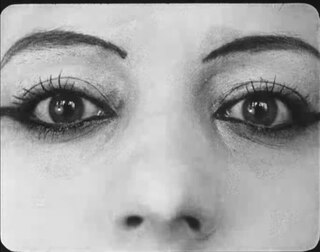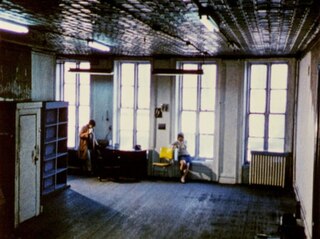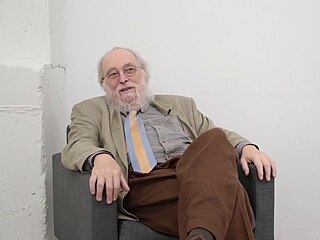Related Research Articles

Experimental film or avant-garde cinema is a mode of filmmaking that rigorously re-evaluates cinematic conventions and explores non-narrative forms or alternatives to traditional narratives or methods of working. Many experimental films, particularly early ones, relate to arts in other disciplines: painting, dance, literature and poetry, or arise from research and development of new technical resources.
Structural film was an avant-garde experimental film movement prominent in the United States in the 1960s. A related movement developed in the United Kingdom in the 1970s.

Wavelength is a 1967 experimental film by Canadian artist Michael Snow. Shot from a fixed camera angle, it depicts a loft space with an extended zoom over the duration of the film. Considered a landmark of avant-garde cinema, it was filmed over one week in December 1966 and edited in 1967, and is an example of what film theorist P. Adams Sitney describes as "structural film", calling Snow "the dean of structural filmmakers."

Flaming Creatures is a 1963 American experimental film directed by Jack Smith. The film follows an ensemble of drag performers through several disconnected vignettes, including a lipstick commercial, an orgy, and an earthquake. It was shot on a rooftop on the Lower East Side on a very low budget of only $300, with a soundtrack from Smith's roommate Tony Conrad. It premiered April 29, 1963 at the Bleecker Street Cinema in Greenwich Village.
Gregory J. Markopoulos was a Greek-American experimental filmmaker.

P. Adams Sitney, is a historian of American avant-garde cinema. He is known as the author of Visionary Film, one of the first books on the history of experimental film in the United States.
Robert Beavers is an American experimental filmmaker. Born and raised in Massachusetts, he attended Deerfield Academy which he left before graduating to move to New York in 1965 to pursue filmmaking. He lived in New York until 1967 when he and his partner, Gregory Markopoulos, left the United States for Europe, where they continued to live and make films until Markopoulos's death in 1992.

Zorns Lemma is a 1970 American structural experimental film by Hollis Frampton. Originally starting as a series of photographs, the non-narrative film is structured around a 24-letter classical Latin alphabet. It remains, along with Michael Snow's Wavelength and Tony Conrad's The Flicker, one of the best known examples of structural filmmaking.
Cosmic Ray is a 1962 American experimental short film directed by Bruce Conner. With both found footage and original material, it features images of countdown leader, a nude woman dancing, a Mickey Mouse cartoon, and military exercises. It is soundtracked by a performance of Ray Charles's "What'd I Say" and has been recognized by some critics as one of the first music videos.
Hapax Legomena is a seven-part film cycle by American experimental filmmaker Hollis Frampton. The complete cycle premiered in November 1972.
Normal Love is an experimental film project by American director Jack Smith. It shows the adventures of an ensemble of glamorously dressed monsters. Smith filmed the project in 1963 and began screening the work in pieces in 1964.
Arnulf Rainer is a 1960 Austrian experimental short film by Peter Kubelka, and one of the earliest flicker films. The film alternates between light or the absence of light and sound or the absence of sound. Since its May 1960 premiere in Vienna, Arnulf Rainer has become known as a fundamental work for structural film. Kubelka released a "negative" version, titled Antiphon, in 2012.

Jerome Hiler is an American experimental filmmaker, painter, and stained glass artist. Having started in New York during the New American Cinema movement, Hiler and his partner Nathaniel Dorsky moved in 1971 to San Francisco, where for many years his work was shown in the context of private salon screenings. He began to publicly screen his films in the late 1990s, releasing new films regularly since 2010. Hiler's work makes use of vivid colors, musical rhythms or structures, and layered superimpositions edited in camera.
Anticipation of the Night is a 1958 American avant-garde film directed by Stan Brakhage. It was a breakthrough in the development of the lyrical style Brakhage used in his later films.
Variations is a 1998 American short silent avant-garde film directed by Nathaniel Dorsky. It is the second film in a set of "Four Cinematic Songs", which also includes Triste, Arbor Vitae, and Love's Refrain.
Adebar is a 1957 Austrian avant-garde short film directed by Peter Kubelka. It is the first entry in Kubelka's trilogy of metrical films, followed by Schwechater and Arnulf Rainer. Adebar is the first film to be edited entirely according to a mathematical rhythmic strategy.
Christmas on Earth is a 1963 American experimental short film directed by Barbara Rubin.

Light Industry is an American microcinema founded by Ed Halter and Thomas Beard. Since 2008 it has operated in several locations around Brooklyn, New York. Its programming focuses on obscure and unusual works.

Twice a Man is a 1963 American avant-garde film directed by Gregory Markopoulos.
The Illiac Passion is a 1968 American avant-garde film directed by Gregory Markopoulos.
References
- ↑ Balsom 2017, pp. 213.
- 1 2 Lee, Nathan (2004). "From Here to Eternity". Film Comment . Vol. 40, no. 1. pp. 52–55.
- 1 2 Rutkoff, Rebekah (September 8, 2014). "Frame of Mind". Artforum . Retrieved 30 August 2024.
- 1 2 3 Rutkoff, Rebekah (2020). "Other Galaxies: The Temenos Beyond the Screen". Framework: The Journal of Cinema and Media. 61 (2): 158–179. doi:10.13110/framework.61.2.0158. JSTOR 10.13110/framework.61.2.0158.
- ↑ Goldsmith, Leo (1 August 2022). "Image, Sound, and Silence: Temenos 2022". Film Comment . Retrieved 30 August 2024.
- ↑ Balsom 2017, p. 200.
- ↑ Sitney 2014, pp. 217–218.
- ↑ Balsom 2017, p. 203.
- ↑ Balsom 2017, pp. 204–206.
- ↑ Sitney, P. Adams (November 2004). "Idyll Workshop". Artforum . Vol. 43, no. 3. p. 189. Retrieved 28 August 2024.
- ↑ Balsom 2017, pp. 211–212.
- ↑ Wang, Michael (12 July 2008). "Silent Nights". Artforum . Retrieved 30 August 2024.
- 1 2 Sitney 2014, p. 218.
- ↑ Sitney, P. Adams (October 2022). "Arcadian Rhapsody". Artforum . Vol. 61, no. 2. Retrieved 30 August 2024.